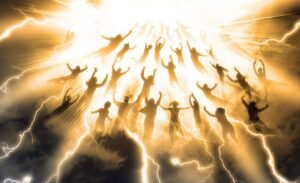When reading the Bible, “context” can make all the difference in understanding a verse of the Bible. Just like walking in 45 minutes into an hour long TV show, without the context one does not know what is truly happening on the show. In Biblical terms we see this Biblical study principle of context concerning Luke 16:19-31, the story of “Lazarus and the rich man”. To properly understand this small section of scripture we must read what Christ said in context, both historically and theologically. Was Lazarus in “heaven” and the rich man in “hell”? Do these verses suggest an eternal torment for sinners (See CSCOG7 Staff Hell)? Or does “context” help us to understand these verses?
- First we must understand a profound Biblical understanding: All humans die. We do NOT have an immortal soul (See CSCOG7 Staff Immortal soul). The Bible is extremely clear that at human death all people are simply dead! Ecc.3:19; Heb. 9:27; I Cor. 15:22; and Gen. 3:16 all show when humans die they are dead, they go back to the dust of the ground they were created of. After death one is not in heaven nor are they in what we think of as hell. Acts 2:29 tells us even King David is dead and buried and verse 34 is specific that David is not in heaven. Rom. 5:12 says, “so death passes upon all men”. Rom. 6:23a says, “The wages of sin are death”.
- After death then what? The resurrection. I Cor. 15:22-23 All people will die and then be resurrected in his own order. I Cor. 15:51-54 we see death is swallowed up in victory. Verse 55 says “O death where is thy sting”. After death and being in the grave (Greek “Hades” meaning pit or hole and Hebrew “Sheol” meaning pit or hole) all will be resurrected whether to life forever after with Christ or to judgment and eternal death. Rev. 20:4 The Saints are resurrected (Lazarus) and verses 5-6 sinners (the rich man) are resurrected to eternal judgment and the sinners are thrown into the lake of fire where they (as all flesh would be) are burned up and become ashes under the feet of the saints (Mal. 4:3). The fate of the sinner is total annilation-death forever (Matt. 13:30; 3:12; Mal. 4:1-3). Dead forever and forgotten. Eternal punishment not eternal punishing. God is much more merciful than He is given credit for. Quick, eternal punishment of death without everlasting pain and suffering in a hell fire is the ultimate fate of the sinner.
Now that we understand that all die and then are resurrected to life with Jesus or to eternal death as punishment for sins we can read Luke 16:19-31 in both historical and theological context.
Luke 16:22 we see both Lazarus and the rich man died. They are dead and in the grave. Even Abraham and the prophets are dead and in the grave (John 8:52). Luke 16:22b What is Abraham’s bosom? To be in ”ones bosom” is to have that persons love and protection, and share his blessings and inheritance (John 1:18; Num. 11:12; Isa. 40:11). We see that Lazarus was in the protection of Abraham and was to share in the inheritance of Abraham. Abraham was to inherit the earth and his seed was to inherit the earth with him (Gen. 12:5-7; 13:15; 15:18; Rom. 8:14-18). The promise to Abraham was “forever” therefore the promise included eternal life in the resurrection. This eternal life is in the future as we read in Rev. 20:4-6. The question is when did Luke 16:19-31 take place? The answer is at the future resurrection. Rev. 20:4 is the resurrection for Lazarus and Rev. 20:5-6 is the second resurrection for the rich man who suffers eternal judgement for his sins. There is a 1000 year difference between the resurrection of Lazarus and the rich man (Rev;20:4). Luke 16:23-24 both Lazarus and the rich man were dead in the grave (Hades). The rich man upon his resurrection to judgment cried out to Abraham and Lazarus for mercy as he was entering the lake of fire. This was the “sting of death”, that realization one is about to die the second death. Lazarus and the rich man were divided by a great gulf (Luke 16:26) and that great gulf was immortality. Lazarus had immortality with God and the rich man did not. Immortality granted to the righteous of God (Rom. 6:23b), in this case Lazarus and the second death of eternal punishment for the sinner, in this case the rich man (Rom. 6:23a).
Luke 16:30-31 clearly show Jesus was giving a description of the future resurrections of both the righteous and the sinner. One who hears Moses and the prophets to everlasting life with Jesus and one who hears not Moses and the prophets to everlasting death.
Far from Luke 16:19-31being a description of sinners burning in an everlasting hell fire of torment, Luke 16 shows the future resurrections and judgement of God upon all mankind. Jesus gave us a vivid understanding that sinners are to die eternally and be ashes under the feet of the saints and those who obey Moses and the prophets to live forever with Jesus in His Kingdom of God.























